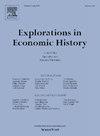War bonds and household saving in WWII
IF 1.7
1区 历史学
Q1 ECONOMICS
引用次数: 0
Abstract
Household saving increased dramatically during World War II, reaching more than 19 percent of GDP. We study the effects of the war bond program implemented by the U.S. government on the level of household saving during the war. The bonds were heavily promoted in a series of drives, which encouraged thrift and associated subscriptions with patriotism, and also through a payroll deduction program. Yet as Friedman and Schwartz have noted, the main effect of the program may have been to change the form in which savings were held, rather than to increase saving. We use county-level data and an instrument for participation in the bond program to estimate the effect of war bond sales on total saving. We find that for every $100 in war bond sales, bank deposit inflows fell by $70, suggesting that while there was substantial substitution between war bonds and bank accounts, the program did actually increase total saving. A back of the envelope calculation suggests that the bond program increased total personal saving by about 7 percent, in large part driven by the voluntary payroll deduction program.
二战中的战争债券和家庭储蓄
第二次世界大战期间,家庭储蓄急剧增加,达到GDP的19%以上。本文研究了美国政府在战争期间实施的战争债券计划对家庭储蓄水平的影响。这些债券在一系列活动中得到大力推广,这些活动鼓励节俭,并将认购债券与爱国主义联系起来,同时还通过一项工资扣除计划。然而,正如弗里德曼和施瓦茨所指出的那样,该计划的主要效果可能是改变了储蓄的形式,而不是增加了储蓄。我们使用县级数据和参与债券计划的工具来估计战争债券销售对总储蓄的影响。我们发现,战争债券每卖出100美元,银行存款流入就会减少70美元,这表明虽然战争债券和银行账户之间存在大量替代,但该计划实际上确实增加了总储蓄。一个粗略的计算表明,债券计划使个人储蓄总额增加了约7%,这在很大程度上是由自愿工资扣除计划推动的。
本文章由计算机程序翻译,如有差异,请以英文原文为准。
求助全文
约1分钟内获得全文
求助全文
来源期刊

Explorations in Economic History
Multiple-
CiteScore
2.50
自引率
8.70%
发文量
27
期刊介绍:
Explorations in Economic History provides broad coverage of the application of economic analysis to historical episodes. The journal has a tradition of innovative applications of theory and quantitative techniques, and it explores all aspects of economic change, all historical periods, all geographical locations, and all political and social systems. The journal includes papers by economists, economic historians, demographers, geographers, and sociologists. Explorations in Economic History is the only journal where you will find "Essays in Exploration." This unique department alerts economic historians to the potential in a new area of research, surveying the recent literature and then identifying the most promising issues to pursue.
 求助内容:
求助内容: 应助结果提醒方式:
应助结果提醒方式:


